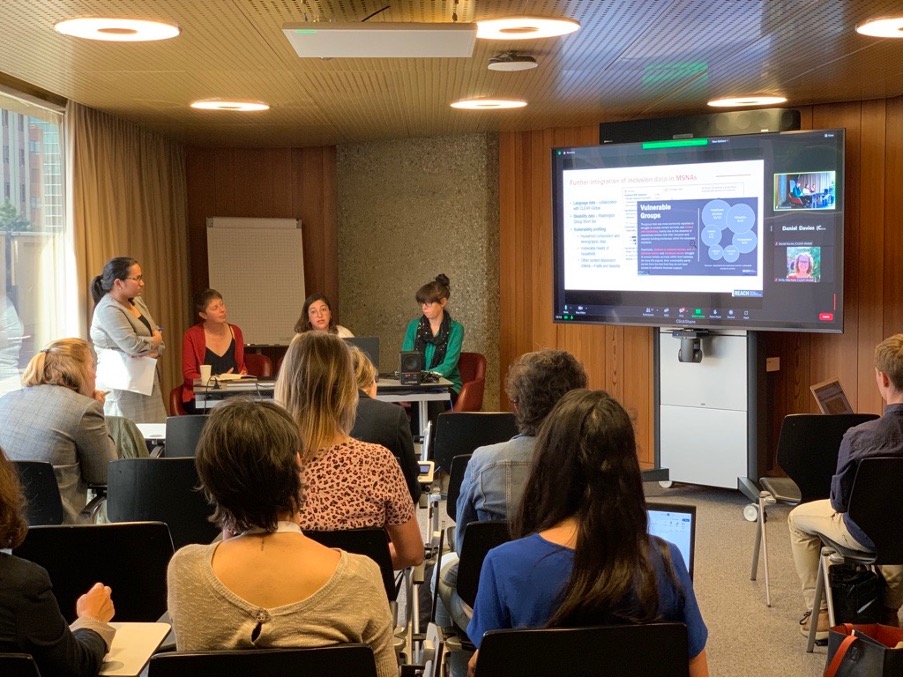Making sense of the data: an important tool to strengthen accountability
Data helps provide evidence of change, and we need more evidence of what is working and what isn’t to bring about the changes needed for greater accountability to affected people (AAP). To do this we need to understand better what we are collecting and how we use it to bring about needed change.
Catherine Skehan, CHS Alliance’s Collective Accountability Manager, joined Ellie Kemp from CLEAR Global and Roxana Mullafiroze of REACH Initiative, to discuss this challenge at a recent Humanitarian Networks & Partnerships Weeks (HNPW) session.
Using the data right
At CHS Alliance, we know that more than 130 dedicated organisations are already measuring how well they are meeting their accountability commitments through CHS verifications, but we need to take this further. The Inter-Agency Standing Committee (IASC) AAP Results Tracker is a first step of the journey to understand and improve AAP at a collective level, because to a person facing crises it’s about how all responders treat them, not individual organisations.
 One of the biggest challenges facing the aid system, is not a lack of data on accountability to affected people, but having the right data, bringing different types of data together, making sense of it, and ensuring sure those with the power to make changes can see it, so that they can take swift and evidence-based action.
One of the biggest challenges facing the aid system, is not a lack of data on accountability to affected people, but having the right data, bringing different types of data together, making sense of it, and ensuring sure those with the power to make changes can see it, so that they can take swift and evidence-based action.
Currently a lot of different levels of data are being collected across the aid system. They are being used in a variety of ways to inform action and make improvements. However, they are not yet being brought together into one place to create an accessible overview that can inform leaders and decision makers.
To address this challenge, CHS Alliance is leading, on behalf of the IASC Accountability to Affected People Taskforce, the development of an Accountability to Affected People Results Tracker. The AAP Results Tracker is designed to bring different types of accountability data into one place and create a monitoring framework that measures how well responses are delivering on AAP. The Results Tracker is designed to provide an accessible overview for all leaders and decision makers to prioritise actions needed to strengthen accountability to people affected by crises.

HNPW session on ‘How Effective Data Collection and Analysis Can Strengthen Accountability to Affected Populations’
Collecting the right data
For any needs assessments, questions on AAP must be embedded from the outset to ensure meaningful data is being collected at this level. Before starting to collect and analyse AAP data, we must also ensure we are collecting data from everyone affected. To do this effectively – linguistic diversity is one of the key first considerations.
In terms of accountability data collection, REACH Initiative have been making considerable progress incorporating AAP questions into their Multi Sector Needs Assessments (MSNA). These are a comprehensive crisis level needs assessment surveys collected at the household level on an annual basis. By 2021 every country REACH MSNA included some AAP questions, covering topics such as satisfaction with the response, satisfaction with aid workers, and people’s preferred communication channels.
Getting the right data is not just about the questions, it’s also about how you ask. CLEAR Global’s data shows that people’s satisfaction levels with a response and their ability to access services are strongly linked to using the right languages. It’s often sections of society with less access to education who miss out when aid organisations only use more dominant languages, as speakers of other languages tend to learn a national or official language at school. That means women and girls, persons with disabilities, older people, and members of marginalised ethnic and social groups can face an extra layer of exclusion through language. CLEAR Global’s research finds that the aid system does not fully consider the linguistic diversity and communication preferences of people affected by a crisis.
“For too long those planning a humanitarian response have operated under the assumption that the majority language of a country will be accessible to most of the people they are trying to support. This is just plain wrong.” said Ellie Kemp, CLEAR Global’s Head of Research, Evidence and Advocacy at the HNPW session.
More early data is needed on language preferences, so that responders can listen and communicate effectively, as well as being held accountable by all those they serve. A lack of information on which languages affected-people use has significant impact on responders’ abilities to communicate with the most vulnerable, most marginalised and least educated people, especially on sensitive topics such as sexual violence or reproductive health.
To address this stark gap, CLEAR Global and REACH Initiative have incorporated language data questions into eight assessments in Afghanistan, Burkina Faso, CAR, DRC, Libya, Mali, Nigeria and Somalia.
By helping those coordinating responses to better understand language preferences, two-way communication strategies can be created that include the most vulnerable, most marginalised and least educated. This means that everyone can be heard and included in the accountability data that goes on to create change.
Catch up on the recording of ‘How Effective Data Collection and Analysis Can Strengthen Accountability to Affected Populations’.
Innovative approaches to strengthening collective accountability to people affected by crises are at the heart of what we do at CHS Alliance. We look forward to sharing more with you as we walk this journey. To learn more and get involved with this exciting work, email Cat Skehan.

